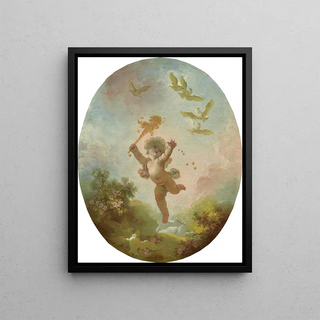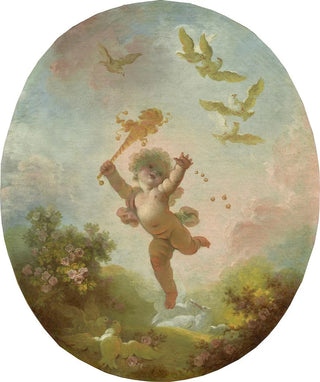Art print | L'amour comme folie - Jean-Honoré Fragonard


View from behind

Frame (optional)
Art print of "L'amour comme folie" by Jean-Honoré Fragonard – Captivating introduction
The artwork "L'amour comme folie," created by Jean-Honoré Fragonard, is an iconic illustration of the Rococo movement, where lightness and carefree spirit blend with palpable sensuality. This canvas, evoking the pleasures of love and youth, transports viewers into a universe where conventions are overturned and passion is expressed freely. Fragonard, a master of color and light, succeeds in capturing the very essence of love, presenting it not merely as an emotion but as a true madness, a whirlwind of fleeting moments and wonder. Gazing upon this piece, one is immediately immersed in a world of charm and beauty, where every detail is carefully designed to evoke an atmosphere of ephemeral happiness.
Style and uniqueness of the artwork
One of the most fascinating aspects of "L'amour comme folie" lies in Fragonard's unique style, which manages to combine delicacy and dynamism. The pastel colors, so characteristic of Rococo, unfold with such harmony that they seem to dance across the canvas. The figures are depicted with almost aerial grace, their movement suggesting a lightness that contrasts with the depth of the emotions they convey. Floral motifs and flowing drapery add a tactile dimension to the piece, inviting viewers to feel the softness of fabrics and the freshness of flowers. Every element of the composition, from radiant faces to delicate gestures, contributes to creating a festive atmosphere where love is celebrated in all its splendor. Fragonard, through his bold and imaginative approach, transcends the conventions of his time, offering a new and captivating vision of human relationships.
The artist and his influence
Jean-Honoré Fragonard, born in 1732 in Grasse, is one of the most emblematic artists of 18th-century France. A pupil of François Boucher, he quickly distinguished himself with his flamboyant style and his ability to capture the intimacy of everyday scenes. Fragonard does not merely reproduce reality; he embellishes it, transforming it into an awakened dream where

Matte finish

View from behind

Frame (optional)
Art print of "L'amour comme folie" by Jean-Honoré Fragonard – Captivating introduction
The artwork "L'amour comme folie," created by Jean-Honoré Fragonard, is an iconic illustration of the Rococo movement, where lightness and carefree spirit blend with palpable sensuality. This canvas, evoking the pleasures of love and youth, transports viewers into a universe where conventions are overturned and passion is expressed freely. Fragonard, a master of color and light, succeeds in capturing the very essence of love, presenting it not merely as an emotion but as a true madness, a whirlwind of fleeting moments and wonder. Gazing upon this piece, one is immediately immersed in a world of charm and beauty, where every detail is carefully designed to evoke an atmosphere of ephemeral happiness.
Style and uniqueness of the artwork
One of the most fascinating aspects of "L'amour comme folie" lies in Fragonard's unique style, which manages to combine delicacy and dynamism. The pastel colors, so characteristic of Rococo, unfold with such harmony that they seem to dance across the canvas. The figures are depicted with almost aerial grace, their movement suggesting a lightness that contrasts with the depth of the emotions they convey. Floral motifs and flowing drapery add a tactile dimension to the piece, inviting viewers to feel the softness of fabrics and the freshness of flowers. Every element of the composition, from radiant faces to delicate gestures, contributes to creating a festive atmosphere where love is celebrated in all its splendor. Fragonard, through his bold and imaginative approach, transcends the conventions of his time, offering a new and captivating vision of human relationships.
The artist and his influence
Jean-Honoré Fragonard, born in 1732 in Grasse, is one of the most emblematic artists of 18th-century France. A pupil of François Boucher, he quickly distinguished himself with his flamboyant style and his ability to capture the intimacy of everyday scenes. Fragonard does not merely reproduce reality; he embellishes it, transforming it into an awakened dream where






